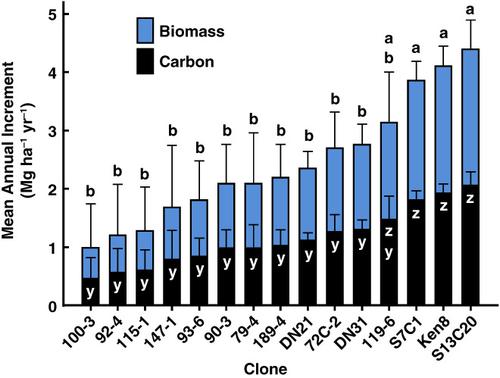当前位置:
X-MOL 学术
›
WIREs Energy Environ.
›
论文详情
Our official English website, www.x-mol.net, welcomes your feedback! (Note: you will need to create a separate account there.)
Ecosystem services of poplar at long‐term phytoremediation sites in the Midwest and Southeast, United States
Wiley Interdisciplinary Reviews: Energy and Environment ( IF 6.1 ) Pub Date : 2019-06-18 , DOI: 10.1002/wene.349 Ronald S. Zalesny 1 , William L. Headlee 2, 3 , Gayathri Gopalakrishnan 4 , Edmund O. Bauer 1 , Richard B. Hall 5 , Dennis W. Hazel 6 , Jud G. Isebrands 7 , Louis A. Licht 8 , M. Cristina Negri 9 , Elizabeth Guthrie Nichols 6 , Donald L. Rockwood 10 , Adam H. Wiese 1
Wiley Interdisciplinary Reviews: Energy and Environment ( IF 6.1 ) Pub Date : 2019-06-18 , DOI: 10.1002/wene.349 Ronald S. Zalesny 1 , William L. Headlee 2, 3 , Gayathri Gopalakrishnan 4 , Edmund O. Bauer 1 , Richard B. Hall 5 , Dennis W. Hazel 6 , Jud G. Isebrands 7 , Louis A. Licht 8 , M. Cristina Negri 9 , Elizabeth Guthrie Nichols 6 , Donald L. Rockwood 10 , Adam H. Wiese 1
Affiliation

|
Short rotation woody crops (SRWCs) including Populus species and their hybrids (i.e., poplars) are ideal for incorporating biomass production with phytotechnologies such as phytoremediation. To integrate these applications, 15 poplar plantings from nine long‐term phytoremediation installations were sampled from 2012 to 2013 in the Midwest (Illinois, Iowa, Wisconsin) and Southeast (Alabama, Florida, North Carolina) United States. In this review, we report summary results of this sampling and how performance at each site compared with comparable phytoremediation systems in the literature. We review significant genotypic differences from each planting within the context of provisioning (i.e., biomass production) and regulating (i.e., carbon sequestration) ecosystem services and how they relate to the need for a cleaner environment during times of accelerated ecological degradation. Overall, the contaminated poplar sites provided these ecosystem services comparable to noncontaminated poplar sites used for bioenergy and biofuels feedstock production. For example, phytoremediation trees at the Midwestern sites had biomass values ranging from 4.4 to 15.5 Mg ha−1 y−1, which was ~20% less relative to bioenergy trees (p = .0938). Results were similar for diameter and carbon, with some genotype × environment interactions resulting in phytoremediation trees exhibiting substantially greater growth and productivity (i.e., +131% at one site). As illustrated in the current review, phytoremediation success can be increased with the identification and deployment of genotypes tailored to grow well and tolerate a broad diversity of contaminants (generalists) (i.e., ‘DN34’, ‘NM6’, ‘7300501’) versus those that significantly outperform their counterparts under unique site conditions (specialists) (i.e., ‘220‐5’, ‘51‐5’, ‘S13C20’).
中文翻译:

美国中西部和东南部长期植物修复基地的杨树生态系统服务
包括杨树种及其杂种(即杨树)在内的短轮伐木本作物(SRWC)是将生物量生产与植物修复等植物技术相结合的理想选择。为了整合这些应用程序,从2012年至2013年在美国中西部(伊利诺伊州,爱荷华州,威斯康辛州)和东南部(阿拉巴马州,佛罗里达州,北卡罗来纳州)对来自9个长期植物修复设施的15个杨树进行了采样。在这篇综述中,我们报告了本次采样的总结结果,以及与文献中类似的植物修复系统相比,每个站点的性能如何。我们在配置(即生物量生产)和调节的背景下,审查了每种种植的显着基因型差异(即碳固存)生态系统服务,以及它们在加速生态退化期间如何与更清洁的环境需求相关联。总体而言,受污染的杨树场地提供了与用于生物能源和生物燃料原料生产的未受污染的杨树场地相当的这些生态系统服务。例如,中西部站点的植物修复树的生物量值范围为4.4至15.5 Mg ha -1 y -1,相对于生物能源树而言约低20%(p= .0938)。直径和碳的结果相似,有些基因型×环境相互作用导致植物修复树的生长和生产力显着提高(即在一个位置上增加了131%)。如本综述所述,通过鉴定和部署适合于良好生长并耐受多种污染物的基因型(植物学家)(即“ DN34”,“ NM6”,“ 7300501”),可以提高植物修复的成功率在独特的现场条件下(专家)(即“ 220-5”,“ 51-5”,“ S13C20”),其性能明显优于同类产品。
更新日期:2019-06-18
中文翻译:

美国中西部和东南部长期植物修复基地的杨树生态系统服务
包括杨树种及其杂种(即杨树)在内的短轮伐木本作物(SRWC)是将生物量生产与植物修复等植物技术相结合的理想选择。为了整合这些应用程序,从2012年至2013年在美国中西部(伊利诺伊州,爱荷华州,威斯康辛州)和东南部(阿拉巴马州,佛罗里达州,北卡罗来纳州)对来自9个长期植物修复设施的15个杨树进行了采样。在这篇综述中,我们报告了本次采样的总结结果,以及与文献中类似的植物修复系统相比,每个站点的性能如何。我们在配置(即生物量生产)和调节的背景下,审查了每种种植的显着基因型差异(即碳固存)生态系统服务,以及它们在加速生态退化期间如何与更清洁的环境需求相关联。总体而言,受污染的杨树场地提供了与用于生物能源和生物燃料原料生产的未受污染的杨树场地相当的这些生态系统服务。例如,中西部站点的植物修复树的生物量值范围为4.4至15.5 Mg ha -1 y -1,相对于生物能源树而言约低20%(p= .0938)。直径和碳的结果相似,有些基因型×环境相互作用导致植物修复树的生长和生产力显着提高(即在一个位置上增加了131%)。如本综述所述,通过鉴定和部署适合于良好生长并耐受多种污染物的基因型(植物学家)(即“ DN34”,“ NM6”,“ 7300501”),可以提高植物修复的成功率在独特的现场条件下(专家)(即“ 220-5”,“ 51-5”,“ S13C20”),其性能明显优于同类产品。



























 京公网安备 11010802027423号
京公网安备 11010802027423号